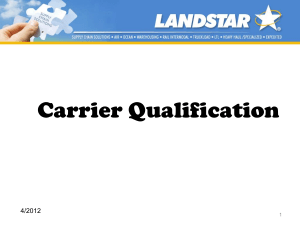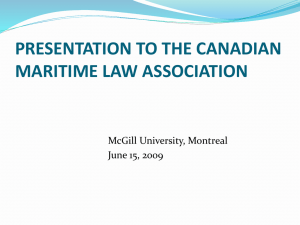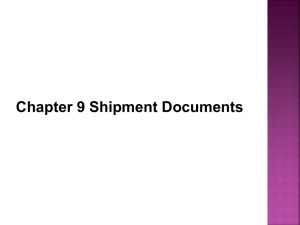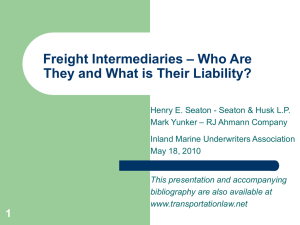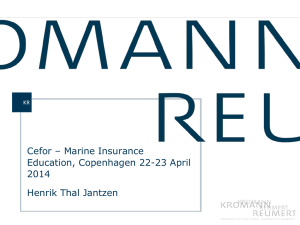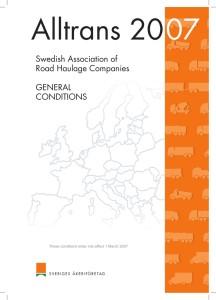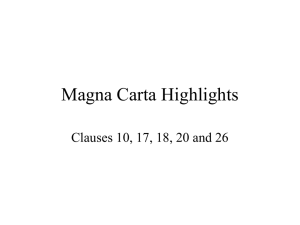Bill of lading
advertisement
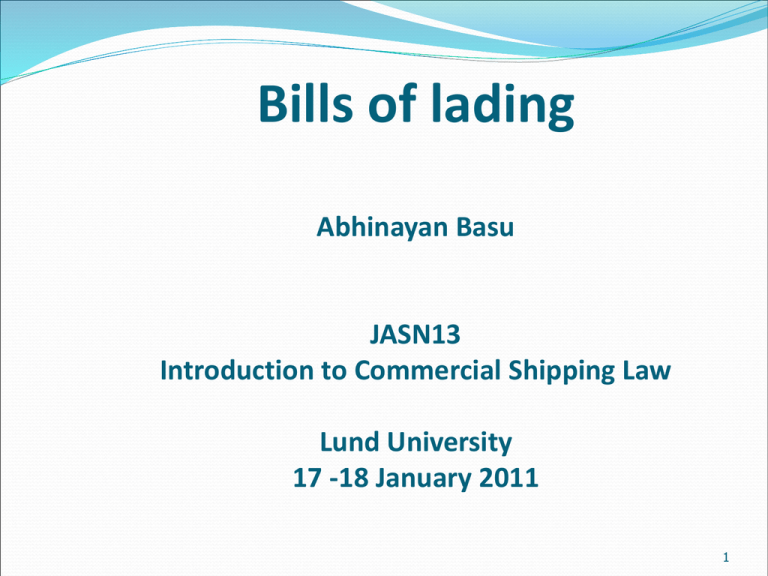
Bills of lading Abhinayan Basu JASN13 Introduction to Commercial Shipping Law Lund University 17 -18 January 2011 1 International sale involves several contracts Sale contract Charterparty (C/P) Bill of lading (B/L) Letters of credit 2 Functions of Bill of Lading (i) Receipt for goods received on board and prima facie evidence of weight, quality, quantity and condition of goods; clean or claused bill of lading; “shipped” or “received for shipment” bill of lading; mate’s receipt; estoppel when in the hands of someone other than the shipper (i.e., lawful holder or endorsee) (ii) Document of title; right to take delivery of goods; transfer of title by endorsement. 3 Functions of Bill of Lading (iii) Evidence of the terms of a contract of carriage between the shipper and carrier; the terms are usually subject to one of the international conventions. If the charterparty is a contract of carriage and the bill of lading is also a contract of carriage, which contract governs the carriage of the cargo on the voyage in question? where the B/L is issued to the charterer as shipper (i.e., CIF or C&F) = C/P where the B/L is subsequently acquired by the charterer as receiver or intermediate buyer (i.e., FOB) = C/P any other case = B/L (because the holder of the B/L will not a party to the C/P; he will not be the charterer of the vessel) 4 Bill of lading : Negotiable Instrument Property in common law and civil law systems are usually in terms of personality and realty or movable and immovable. Personal property is held as a chose in possession (tangible) or a chose in action (intangible). Endorsement of a chose in action transfers right of title from one holder to another for valuable consideration. This makes the chose in action a negotiable instrument. Sea waybill is generally considered to be a non-negotiable instrument; in the Rafaela S case it was held by the House of Lords that a “straight” bill of lading can be considered as a document of title. 5 Historical Evolution Strict liability of carrier Contracting out of strict liability through exemption clauses Harter Act of the United States in 1893 The Hamburg Rules adopted in 1885 National legislation of Canada, Australia, New Zealand CMI conference in 1922 Adoption of Hague Rules in 1924 CMI Stockholm Conference in 1963 leading up to Visby Protocol in 1968 Adoption of Hamburg Rules in 1978 1998 to 2008 – CMI and UNCITRAL deliberations leading up to the Rotterdam Rules in 2009 6 Salient Features of Hague/ Hague Visby Rules Definitions Scope and Period of Application Seaworthiness and cargoworthiness Duty to issue bill of lading No Contracting Out Carrier’s Defences, Catalogue of Exceptions Time for suit Limitation of Liability Burden of proof Carrier’s duty to care for cargo Breaking limitation Himalaya clauses Deviation 7 Definitions "contract of carriage" applies only to contracts of carriage covered by a bill of lading or any similar document of title,… What if bill of lading not issued yet? E.g., damage occurs during loading? Pyrene v. Scindia; it is contemplated that bill of lading will be issued. What if bill of lading not issued at all? Happy Ranger; Specimen form, bill of lading never issued; damage during loading in Italy; intended to be covered by bill of lading. 8 Definitions Bill of lading or similar document of title: Received for shipment – Art III r 3 Through or combined transport bill of lading (sea leg) Straight bill of lading – Rafaela S Documents regarded as documents of title in custom or trade Except if marked non-negotiable; e.g., mate’s receipt Documents acknowledging shipment Receipts of cargo retained by consignor Ship delivery order Not sea waybill 9 Definitions Art I (c): “goods” excluded from the Rules – live animals, deck cargo – excluded for policy reasons – greater risks with these cargoes Precondition for deck cargo to be excluded: clear statement that goods are carried on deck; and in fact cargo is so carried; it is not enough to have general liberty clause to carry cargo on deck (Svenska Traktos) 10 Scope of Application The geographical scope (from where is the shipment?) - Art X (a) – (b) The provisions of these Rules shall apply to every bill of lading relating to the carriage of goods between ports in two different States if: (a) the bill of lading is issued in a Contracting State, or (b) the carriage is from a port in a Contracting State,… The documentary approach – Art I (b) – definition of contract of carriage "contract of carriage" applies only to contracts of carriage covered by a bill of lading or any similar document of title, … 11 Scope of Application Express incorporation in bill of lading – Art X (c) … (c) the contract contained in or evidenced by the bill of lading provides that these Rules or legislation of any State giving effect to them are to govern the contract, (Tunisia is a contracting state to the Hamburg Rules. But all the ships of the government owned shipping company of Tunisia incorporates Hague-Visby Rules in their bills of lading). whatever may be the nationality of the ship, the carrier, the shipper, the consignee, or any other interested person. Incorporation must be express and specific 12 Scope of Application Incorporation in charterparties The Rules do not apply to charterparties by force of law; Art V. Can apply contractually through a Paramount Clause which is a term of art meaning incorporation of the Rules in a charterparty. 13 Period of Application Art I (e) - "carriage of goods" covers the period from the time when the goods are loaded on to the time they are discharged from the ship. Operation of the Rules determined by limits of contract and not by limits of time; Pyrene v. Scindia. Tackle to tackle: If the carrier undertakes to perform loading and discharging then HVR come into operation from the moment cargo is attached to ship’s tackle until the moment ship’s tackle is released at discharge. The extent to which loading and discharging are brought within the carrier’s obligations is left to the parties to decide; (FIOST Terms) 14 Period of Application Art II (subject to Art VI) refers to carrier’s responsibilities, liabilities and immunities from loading to discharge. Art VII allows freedom to the parties to agree terms of liability relating to loading or discharge. 15 Seaworthiness Art III r 1; The carrier shall be bound, before and at the beginning of the voyage, to exercise due diligence to (a) make the ship seaworthy; (b) properly man, equip and supply the ship; (c) make the holds, refrigerating and cool chambers, and all other parts of the ship in which goods are carried, fit and safe for their reception, carriage and preservation. Exercise due diligence implies duty to exercise reasonable care and skill; lack of it is negligence. The duty is non-delegable; The Muncaster Castle Negligence of reputable fitter delegated by owner will not absolve owner from liability. 16 Seaworthiness Exercise of due diligence involves not only that owner personally shall exercise due diligence but also all his servants and agents. Why owner liable? Allocation of risk is on the shipowner and not on the cargo interest. Duration of duty: Art IV r 1: duty extends to period before and at the beginning of the voyage; Maxine Footwear v. Canadian Government Merchant Marine Ltd.; duty starts at least from the beginning of loading till vessel starts in her voyage. Voyage is meant the contractual one from port of loading to the discharge. 17 Seaworthiness Scope of the duty: make ship physically seaworthy; properly man, equip and supply the ship; make the holds, refrigerating and cool chambers, and all other parts of the ship in which goods are carried, fit and safe for their reception, carriage and preservation. Examples of physical condition Failure to secure nuts in storm valves Fatigue cracks in reduction gear (breakdown) Failure of steering gear after commencement of voyage (stranding) Fracture in shell plating due to fatigue after serious damage to frames and brackets during log trade. 18 Seaworthiness Examples of improper manning Inefficiency of chief engineer to check sufficiency of burnable oil, lack of which caused breakdown Inefficiency of chief engineer who opened wrong valve during pumping operations Lack of fire fighting training Due diligence requires owner to examine competence of crew and not just relying on certificates Example of insufficient equipment Failure to provide plans of engine room Failure to provide plan of ballast and fuel system Inadequate number of functioning walkie-talkies, defective fire extinguishers, lack of specific documents dealing with danger of fire Insufficient bunkers 19 Seaworthiness Cargoworthiness: Holds, refrigeration and cool chambers, and other parts carrying cargo must be fit and safe to receive and carry the particular cargo; any contamination or unclean tanks damaging cargo will make the ship uncargoworthy. Art III r 1 is an overriding obligation which means if not fulfilled, carrier cannot invoke Art IV immunities; e.g., where the unseaworthiness caused fire, carrier could not rely on defence in Art IV r 2 (b); any clause in the bill of lading lowering liability by agreement is null and void (Art III r 8). 20 Seaworthiness - Burden of proof The cargo interests must prove Contract with the carrier Non-delivery or damage to goods carried Burden shifts to carrier to show prima facie he is covered by exemptions, e.g., negligent navigation Burden returns to cargo interests Ship was unseaworthy (sometimes is inferred) Damage was caused by unseaworthiness Carrier to show he and his servants/agents exercised due diligence (Art IV r 1); failing that, no reliance on immunities of Art IV r 2. 21 Carrier’s duty to care for cargo Art III r 2: Subject to the provisions of Article IV, the carrier shall properly and carefully load, handle, stow, carry, keep, care for and discharge the goods carried. It is not an overriding obligation like Art III r 1 but continuous; meaning there is prima facie an obligation under Art III r 2 which may be displaced by provisions of Art IV r 2 qualifying liability which the carrier might otherwise be under. The extent to which loading and discharging are brought within carrier’s obligation is left to parties to decide. Freedom of contract to delineate the scope of the obligations of Art III r 2. Like Art III r 1, it is non delegable duty; International Packers Careful means without negligence Properly means with a sound system 22 Duty to issue bill of lading Art III r 3 To issue bill of lading for its document of title function To ensure the bill of lading contains certain matters for its function as a receipt; facilitating its use in connection with sale of goods contract and letters of credit; providing essential information for a cargo claim Shipper is entitled and can demand issue of bill of lading ‘shipped and received’ Art III r 7 Bill of lading is issued only if shipper demands, Art III r 3 On demand is construed as within reasonable time which in circumstances must be very short 23 Duty to issue bill of lading Art III r 3 Bill of lading contains minimal description Leading marks Packages or pieces, quantity Apparent order and condition The above have probative value, Art III r 4, prima facie evidence, but proof to contrary not admissible if bill of lading transferred to third party acting in good faith Art III r 5 – shipper guarantees statements on bill of lading; gives carrier right of indemnity against shipper 24 No Contracting Out Art III r 8: Any clause, covenant or agreement in a contract of carriage relieving the carrier or the ship from liability for loss or damage to or in connection with goods arising from negligence, fault or failure in the duties and obligations provided in this Article or lessening such liability otherwise than as provided in these Rules, shall be null and void and of no effect. Clauses held invalid: A choice of law or forum clause resulting in lowering limit of liability Arbitration clause limiting the time limit set in Art III r 6 Clause relieving carrier from correct delivery infringing Art IV r 2 (n), (o) Clause undermining obligation of seaworthiness 25 No Contracting Out Valid clauses Any clause not lessening carrier’s liability - ‘one way mandatory’ Liberty to transship on terms consistent with Art III Arbitration clause if no less time limit FIOST terms 26 Carrier’s Defences, Catalogue of Exemptions (a) act, neglect, or default of the master, mariner, pilot or the servants of the carrier in the navigation or in the management of the ship; ‘navigation’ – something affecting safe sailing ‘management’ – acts not affecting sailing but the vessel itself Want of care of cargo vs. Management Failure to use tarpaulins meant to cover cargo vs. failure to use locking bars to secure tarpaulin in rough weather (want to care of ship indirectly affecting cargo) Theft of cover plate to hold was not default in management of ship Whose negligence? Negligence of master, crew, servants of carrier and not negligence of carrier himself 27 Carrier’s Defences, Catalogue of Exemptions (b) fire, unless caused by the actual fault or privity of the carrier; means without the personal fault of the carrier or the directing mind of the company (c) perils, dangers and accidents of the sea Perils or accidents must be fortuitous and unexpected, not dangers from ships decay or wear and tear from action of winds and waves Casualty that could not be foreseen as necessary incident of adventure Weather can been seen by forecasts; severe weather not worse than reasonably expected weather in a particular region Perils of the sea need not be unpredictable and unforeseen as there is no such mention in the language of paragraph (c); would carrier be protected if he was aware of adverse weather? (Bunga Seroja [1999] – Australian case) 28 Carrier’s Defences, Catalogue of Exemptions (d) act of God; (e) act of war; (f) act of public enemies; (g) arrest or restraint of princes, rulers or people, or seizure under legal process; (h) quarantine restrictions; (i) act or omission of the shipper or owner of the goods, his agent or representative; (j) strikes or lock-outs or stoppage or restraint of labour from whatever cause, whether partial or general; (k) riots and civil commotions; (l) saving or attempting to save life or property at sea; 29 Carrier’s Defences, Catalogue of Exemptions (m) wastage in bulk or weight or any other loss or damage arising from inherent defect, quality or vice of the goods; wastage same as leakage inherent vice means unfitness to withstand ordinary transit (fish bacteria) (n) insufficiency of packing; packing to be done in accordance with normal practice for goods on such voyage it may be apparent on loading (o) insufficiency or inadequacy of marks; insufficiency of marks may cause misdelivery (p) latent defects not discoverable by due diligence; 30 Carrier’s Defences, Catalogue of Exemptions (q) any other cause arising without the actual fault and privity of the carrier Catch all provision; ‘any other cause’ is construed widely although it does not state ‘whatsoever’. ejusdem generis rule (of the same kind) does not apply Often used when other exceptions do not apply; e.g. stevedore’s servants stole cargo But carrier must prove without actual fault of privity; but if evidence obscure, carrier liable Also covers carrier’s servants and agents 31 Time for suit A cargo claimant is required to file a suit against the carrier within one year before the action is time barred Art III (6) sets out in detail the procedure that a claimant must comply with in order to bring an action against the carrier. 32 Limitation of Liability Unless nature and value of goods is declared before shipment and inserted in bill of lading Art IV r 5 - … neither the carrier nor the ship shall in any event be or become liable for any loss or damage … in an amount exceeding 666.67 units of account per package or unit or 2 units of account per kilo … Unit of account is the special drawing right (SDR) defined by IMF Converted into national currency … on date to be determined by the law of court seized of case. 33 Limitation of Liability package: a bundle of things packed up or whether in a box or separately or unit: is it synonymous to package? Is it a freight unit by which bulk cargo can be measured? Is it a unit such as a car? Containers – Art IV r 5 (c): for contents to be taken into account must be enumerated in bill of lading If bill of lading qualified by ‘said to contain’ or ‘weight, number etc. unknown’ clauses – does it negate enumeration? What is its effect? 34 Breaking limitation Art IV r 5 (e): if proved that the damage resulted from an act or omission of the carrier done with intent to cause damage, or recklessly and with knowledge that damage would probably result; same test as in 1976 Limitation Convention. Different from the Hague Rules which followed the “actual fault or privity” doctrine. 37 Himalaya clauses A Himalaya clause is a contractual provision expressed to be for the benefit of a third party who is not a party to the contract. The clause takes its name from a decision of the English Court of Appeal in the case of Adler v. Dickson (The Himalaya). It is accepted as a “stipulation for another” (“stipulation pour autrui”) under the civil law, without any new law or jurisprudence. Whether stevedores could benefit from the carrier’s package limitation or time-for-suit provision? 38 Himalaya clauses With growth of multimodal shipments, a much broader range of the carrier’s subcontractors wanted to claim the benefit of a broader range of the carrier’s defences and limitations of liability, including inland carriers that were unrelated to the maritime aspects of the contract. Article IV bis of the Hague-Visby Rules attempts to extend “Himalaya” protection to at least the carrier’s servants and agents, although not to independent contractors. Courts in most jurisdictions have concluded that third parties would be protected if the bill of lading included an adequate “Himalaya clause,” and most carriers now incorporate adequate Himalaya clauses into their bills of lading. 39 Deviation Art IV r 4: Any deviation in saving or attempting to save life or property at sea or any reasonable deviation shall not be deemed to be an infringement or breach of these Rules or of the contract of carriage, and the carrier shall not be liable for any loss or damage resulting therefrom. Liberty to deviate clauses: Usual to contain liberty in bill of lading Are such clauses invalid by Art III r 8? Matter of construction; they define scope of contracted voyage; courts strive to narrow the application of a liberty clause; liberty clause is a valid contractual clause 40 Deviation Consequences of deviation: Unauthorized deviation breach of contract; remedy damages for delay Displacement of contract? Fundamental breach? Modern approach: deviation can be explained on the basis of the interpretation of contract rule. 41
